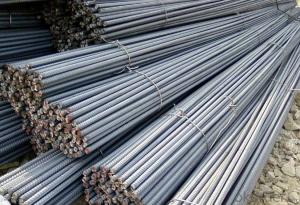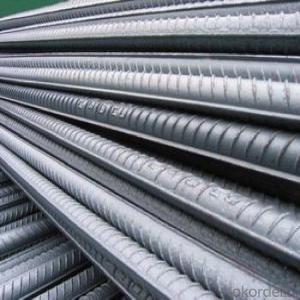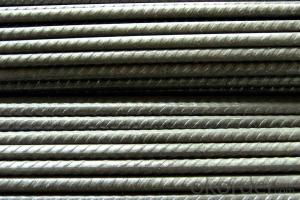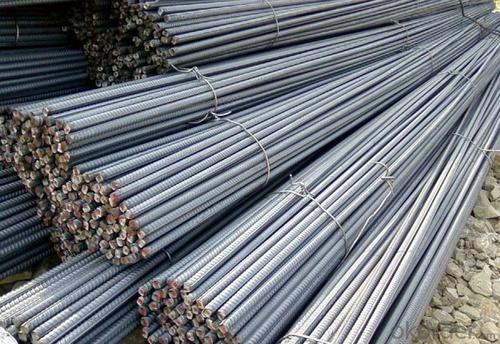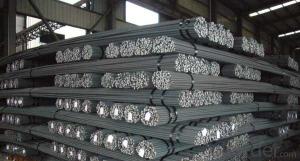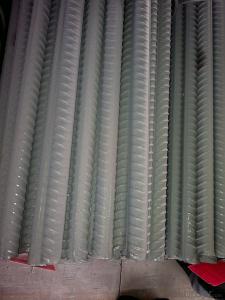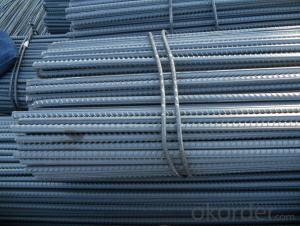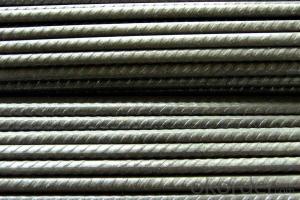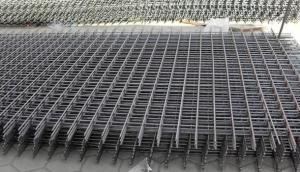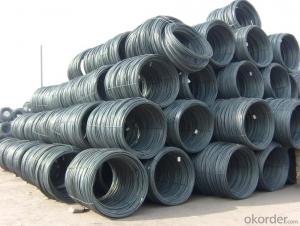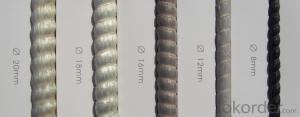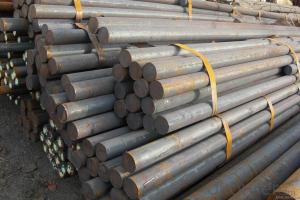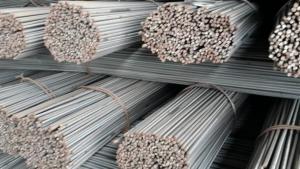Deformed steel bar
- Loading Port:
- China Main Port
- Payment Terms:
- TT OR LC
- Min Order Qty:
- -
- Supply Capability:
- -
OKorder Service Pledge
OKorder Financial Service
You Might Also Like
Product Description:
Specifications of Deformed Steel Bar:
Standard | GB | HRB335, HRB400, HRB500 | |
UK | G460B, B500A, B500B,B500C | | |
USA | GR40, GR60 | | |
Diameter | 6mm,8mm,10mm,12mm,14mm,16mm,18mm,20mm, 22mm,25mm,28mm,32mm,36mm,40mm,50mm | | |
| | |||
Length | 6M, 9M,12M or as required | | |
Place of origin | Hebei, China mainland | | |
Application | building,construction,road,bridge etc | | |
Brand name | DRAGON | | |
Theoretical weight and section area of each diameter as below for your information:
Diameter(mm) | Section area (mm²) | Mass(kg/m) |
6 | 28.27 | 0.222 |
8 | 50.27 | 0.395 |
10 | 78.54 | 0.617 |
12 | 113.1 | 0.888 |
14 | 153.9 | 1.21 |
16 | 201.1 | 1.58 |
18 | 254.5 | 2.00 |
20 | 314.2 | 2.47 |
22 | 380.1 | 2.98 |
25 | 490.9 | 3.85 |
28 | 615.8 | 4.83 |
32 | 804.2 | 6.31 |
36 | 1018 | 7.99 |
40 | 1257 | 9.87 |
50 | 1964 | 15.42 |
Usage and Applications of Deformed Steel Bar:
Deformed bar is widely used in buildings, bridges, roads and other engineering construction. Big to highways, railways, bridges, culverts, tunnels, public facilities such as flood control, dam, small to housing construction, beam, column, wall and the foundation of the plate, deformed bar is an integral structure material. With the development of world economy and the vigorous development of infrastructure construction, real estate, the demand for deformed bar will be larger and larger..
Packaging & Delivery of Deformed Steel Bar:
Packaging Detail: products are packed in bundle and then shipped by container or bulk vessel, deformed bar is usually naked strapping delivery, when storing, please pay attention to moisture proof. The performance of rust will produce adverse effect.
Each bundle weight: 2-3MT, or as required
Payment term: TT or L/C
Delivery Detail: within 45 days after received advanced payment or LC.
Label: to be specified by customer, generally, each bundle has 1-2 labels
Trade terms: FOB, CFR, CIF
Deformed Steel Bar in Coil
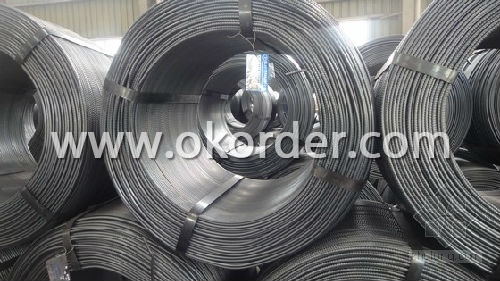
Produce Line of Deformed Steel Bar
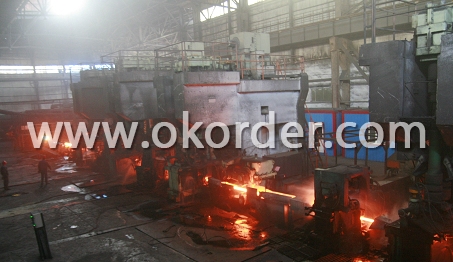
Note:
1. Our products are produced according to national standard (GB), if not, supply according to national standards (GB) or agreement as customer required.
2. Other Grade and Standard Deformed Steel Bar we can supply:
Grade: GR40/GR60, G460B/B500A/B500B/B500C,BST500S
Standard: ASTM, BS, DIN
The Minimum Order Quantity of these products is high, and need to be confirmed.
3. We can not only supply Deformed Steel Bar; if you need anything about building materials, please contact us for further information.
4. Please send us your detail specifications when inquire. We will reply to you as soon as possible. We sincerely hope we can establish a long stable business relationship.
- Q: How do steel rebars prevent cracks and structural failures?
- Steel rebars prevent cracks and structural failures by providing reinforcement and strength to concrete structures. When embedded in concrete, rebars enhance the tensile strength of the overall structure, enabling it to withstand applied forces and loads without cracking or failing. The presence of rebars helps distribute stress and load more evenly throughout the concrete, reducing the likelihood of cracks and failures.
- Q: How do steel rebars provide strength to concrete structures?
- Steel rebars provide strength to concrete structures by acting as reinforcement. When embedded within the concrete, rebars enhance its tensile strength, which is otherwise low. As concrete is strong in compression but weak in tension, the rebars resist the tensile forces that can cause cracking or failure in the structure. By distributing and absorbing these tensile forces, steel rebars increase the overall strength, durability, and structural integrity of the concrete.
- Q: Can steel rebars be used in structures with high resistance to vibration?
- Structures with high resistance to vibration can indeed make use of steel rebars. These rebars are frequently employed as reinforcements in concrete structures to enhance their durability and strength. The inclusion of steel rebars bolsters the structural integrity of buildings and infrastructure, rendering them more impervious to a range of forces, including vibrations. Steel rebars possess exceptional tensile strength and stiffness, enabling them to evenly distribute and absorb applied loads throughout the structure. This characteristic helps to minimize concentrated stress points that may trigger vibrations or structural failure. Moreover, steel rebars are effective in controlling crack widths and preventing crack propagation, which further fortifies the structure against vibrations. Furthermore, steel rebars can be tailored to meet specific requirements based on projected vibration levels. By utilizing rebars with suitable diameters, spacing, and anchorage details, structures can be engineered to withstand vibrations caused by various external factors, such as earthquakes, wind loads, or nearby machinery. It is of utmost importance to ensure proper design and detailing of steel rebars in structures with high resistance to vibration. The layout of reinforcements must be meticulously planned to account for anticipated forces and vibrations. Additionally, the rebars should be adequately anchored and connected to other structural components to maintain their efficacy in combatting vibrations. All in all, when designed and implemented correctly, steel rebars serve as a dependable and widely-used reinforcement material that significantly enhances the resistance of structures to vibrations.
- Q: What are the guidelines for spacing and positioning steel rebars in concrete structures?
- The guidelines for spacing and positioning steel rebars in concrete structures are critical to ensure the structural integrity and durability of the construction. Here are some key guidelines to follow: 1. Rebar Spacing: The spacing between steel rebars in concrete structures is determined by the structural engineer or designer. It is typically expressed in terms of center-to-center spacing or clear distance between rebars. The spacing depends on the load requirements, concrete strength, and other factors specific to the project. The most common spacing ranges from 4 to 12 inches. 2. Cover Depth: The concrete cover depth refers to the distance between the outer surface of the concrete and the nearest surface of the rebar. It is essential to provide adequate cover to protect the rebars from environmental factors, such as corrosion and fire. The cover depth is typically specified in the project's design and can vary depending on the concrete's exposure conditions. 3. Rebar Positioning: The proper positioning of rebars is crucial to ensure they are placed in the designated locations within the concrete structure. The rebars should be securely supported and maintained in the correct alignment during the concrete pouring process. The positioning requirements may include specific lap lengths, overlaps, or hooking of rebars at junctions to ensure proper load transfer and structural continuity. 4. Chair Supports: Rebar chair supports are widely used to maintain the correct spacing and elevation of the rebars within the concrete structure. These supports are placed under the rebars at regular intervals to prevent sagging or displacement during concrete placement. The appropriate chair support type and height should be selected based on the project's requirements and the diameter of the rebars. 5. Tying and Binding: Proper tying and binding of rebars are essential to ensure they remain in position and maintain the required spacing during the concrete pouring process. Rebars should be tied securely using wire or rebar ties at appropriate intervals, typically every 12-18 inches. The ties should be tight enough to prevent movement but not overly tight to avoid damaging the rebars or causing concrete segregation. 6. Concrete Consolidation: During concrete placement, it is crucial to properly consolidate the concrete around the rebars to eliminate air voids and ensure adequate bonding between the concrete and the rebars. Vibrators or other consolidation techniques should be used to achieve proper compaction and ensure the rebars are thoroughly embedded in the concrete. Compliance with the guidelines for spacing and positioning steel rebars in concrete structures is essential to guarantee the structural strength, durability, and safety of the construction. It is crucial to consult and follow the project's design specifications and engage qualified professionals to ensure proper execution and adherence to these guidelines.
- Q: What is the lifespan of steel rebars in different environments?
- The lifespan of steel rebars can vary depending on the environment they are exposed to. In general, steel rebars have a long lifespan and can last for many decades in most environments. However, in harsh or corrosive environments such as coastal areas with high salt content or industrial areas with chemical exposure, the lifespan may be reduced. Proper maintenance and protective measures, such as coatings or cathodic protection, can significantly increase the lifespan of steel rebars in these environments.
- Q: Can steel rebars be used in water treatment plants?
- Yes, steel rebars can be used in water treatment plants. Steel rebars are commonly used in the construction of various structures, including water treatment plants, due to their high strength and durability. However, it is important to ensure that the steel rebars are properly coated or protected to prevent corrosion from the exposure to water and chemicals commonly found in water treatment plants.
- Q: What is the difference between deformed and plain steel rebars?
- Deformed steel rebars have ribbed surfaces that provide enhanced bonding with concrete, resulting in improved structural stability. On the other hand, plain steel rebars are smooth in texture and lack the gripping ability of deformed rebars.
- Q: Are there any limitations or disadvantages of using steel rebars?
- Yes, there are limitations and disadvantages of using steel rebars. Firstly, steel rebars are susceptible to corrosion when exposed to moisture and chemicals, leading to structural degradation over time. This corrosion can weaken the reinforcement and compromise the overall strength and durability of the structure. Additionally, steel rebars have a high thermal expansion coefficient, causing them to expand and contract with temperature variations, potentially leading to cracks in the concrete. Furthermore, steel rebars are heavy and require specialized equipment for handling and installation, increasing construction costs. Lastly, steel rebars are a finite resource, and their production contributes to carbon emissions and environmental degradation.
- Q: What are the factors to consider while choosing the right type of steel rebar for a project?
- When choosing the right type of steel rebar for a project, there are several factors to consider. These include the specific requirements of the project, such as the structural design, load-bearing capacity, and environmental conditions. The grade and size of the rebar must also be taken into account, as they determine its strength and ability to withstand forces. Additionally, factors like corrosion resistance, cost, and availability are important considerations to ensure the selected steel rebar is suitable for the project's needs.
- Q: Can steel rebars be used in coastal construction?
- Yes, steel rebars can be used in coastal construction. Steel rebars are commonly used in construction projects, including in coastal areas where they provide crucial reinforcement to concrete structures. The steel rebars are typically coated or treated to prevent corrosion from the saltwater and other coastal elements, ensuring their durability and longevity in coastal environments.
Send your message to us
Deformed steel bar
- Loading Port:
- China Main Port
- Payment Terms:
- TT OR LC
- Min Order Qty:
- -
- Supply Capability:
- -
OKorder Service Pledge
OKorder Financial Service
Similar products
Hot products
Hot Searches
Related keywords
